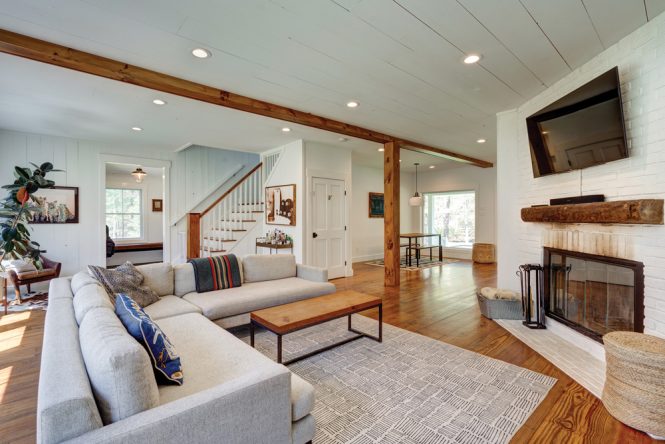Made for the Market
Catskill Farms is Reverse-Engineering Its Homes to Match Buyers' Needs
Presented by Catskill Farms | Photos by Erik Freeland | Fall 2021 | House Feature
Everywhere you turn, the message from the real estate market is clear: The pickings are slim this year. With last year’s run on houses, homeowners’ hesitancy to sell, and many builders’ schedules full-up for the next year, inventory has reached historically low levels.
Where many saw obstacles, however, Chuck Petersheim, founder of Sullivan County-based design/build firm Catskill Farms, saw opportunity. With over 275 homes completed in the Hudson Valley and Catskills since 2002, Petersheim has been correctly guessing the direction of the region’s real estate trends and homebuyers’ needs for two decades. “You talk to enough people—building inspectors, potential clients, real estate agents—and you combine that information to come up with a guess as to where the market is heading,” he says.
After kicking off 2020 with a conservative plan to bring more small homes to the market, Petersheim and his team quickly pivoted during the pandemic to reverse-engineering homes for what the market was newly clamoring for: more space. “You didn’t have to have superhero hearing strength to hear the changing client wishlist. You didn’t need X-ray vision to see the writing on the wall,” Petersheim says. “We quickly but incrementally started offering bigger homes as we gained more information and market insights from the potential clients we were meeting with.”
The firm currently has 23 homes in progress across three counties—a curated mix of farmhouse, cottage, modern ranch, and barn designs that offer features tailor-made for today’s market.
Room to Grow
With so many families looking to move full-time into the Hudson Valley and Catskills during the pandemic, Catskill Farms began expanding its homes’ square footage and offering more acreage. “Smaller homes got harder to sell, not because they didn’t ring the right budget bell, but because people needed more space than they offered,” says Petersheim. “People started to want homes that functioned well as a sometimes-primary home, and that is a bit different than a lightly used second home getaway.”

Photo by Erik Freeland
The average size of Catskill Farms’s homes is currently 2,500 square feet—almost three times the average of early 2020 offerings. Whereas the firm’s small homes have room for sleeping a small family or a couple of friends—a coziness that weekenders enjoy—now the standard is three bedrooms and two baths with finished basements and plenty of room to roam. For example, Barn 43, going up in the Ulster County hamlet of Olivebridge, is a spacious 4,000-square-foot, four-bedroom, four-bath on eight acres.
All About the Amenities
Buyers don’t just want extra space for space’s sake. Propelled in part by the need to create a home upstate that supports rest and relaxation alongside new remote work schedules, buyers want homes designed to support a robust slate of activities. Many of Catskill Farms’s new homes provide just that. Screened-in porches and decks with ample space
for al fresco entertaining and enjoying nature are a must. Many of the new home designs also feature finished basements, which offer additional square footage and flexibility to create a media room, home gym, or office. At a time when pool builders are booked out years in advance, Petersheim’s connections with the region’s tradespeople also means that three new homes in progress in Olivebridge come complete with inground pools perfect for whiling away those picturesque Catskill summers.
“We try to make it hard to say ‘No,’ by really listening to the desires and priorities of the marketplace,” Petersheim says. “It’s rewarding to take that raw information, filter and evaluate it, create a strategic plan based on it, build it, and see if they come. It’s risky, but so far so good.”
